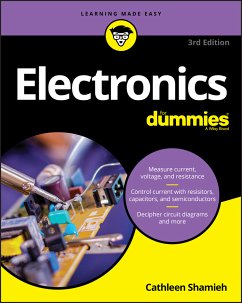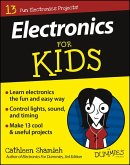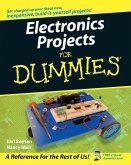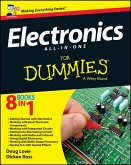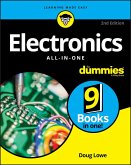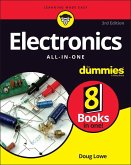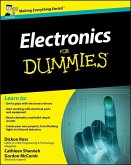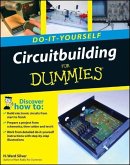Electronics For Dummies (eBook, PDF)


Alle Infos zum eBook verschenken

Electronics For Dummies (eBook, PDF)
- Format: PDF
- Merkliste
- Auf die Merkliste
- Bewerten Bewerten
- Teilen
- Produkt teilen
- Produkterinnerung
- Produkterinnerung

Hier können Sie sich einloggen

Bitte loggen Sie sich zunächst in Ihr Kundenkonto ein oder registrieren Sie sich bei bücher.de, um das eBook-Abo tolino select nutzen zu können.
Build your electronics workbench--and begin creating fun electronics projects right away Packed with hundreds of diagrams and photographs, this book provides step-by-step instructions for experiments that show you how electronic components work, advice on choosing and using essential tools, and exciting projects you can build in 30 minutes or less. You'll get charged up as you transform theory into action in chapter after chapter! * Circuit basics -- learn what voltage is, where current flows (and doesn't flow), and how power is used in a circuit * Critical components -- discover how…mehr
- Geräte: PC
- mit Kopierschutz
- eBook Hilfe
- Größe: 42.2MB
![Electronics For Kids For Dummies (eBook, PDF) Electronics For Kids For Dummies (eBook, PDF)]() Cathleen ShamiehElectronics For Kids For Dummies (eBook, PDF)20,99 €
Cathleen ShamiehElectronics For Kids For Dummies (eBook, PDF)20,99 €![Electronics Projects For Dummies (eBook, PDF) Electronics Projects For Dummies (eBook, PDF)]() Earl BoysenElectronics Projects For Dummies (eBook, PDF)21,99 €
Earl BoysenElectronics Projects For Dummies (eBook, PDF)21,99 €![Electronics All-in-One For Dummies - UK, UK Edition (eBook, PDF) Electronics All-in-One For Dummies - UK, UK Edition (eBook, PDF)]() Dickon RossElectronics All-in-One For Dummies - UK, UK Edition (eBook, PDF)24,99 €
Dickon RossElectronics All-in-One For Dummies - UK, UK Edition (eBook, PDF)24,99 €![Electronics All-in-One For Dummies (eBook, PDF) Electronics All-in-One For Dummies (eBook, PDF)]() Doug LoweElectronics All-in-One For Dummies (eBook, PDF)19,99 €
Doug LoweElectronics All-in-One For Dummies (eBook, PDF)19,99 €![Electronics All-in-One For Dummies (eBook, PDF) Electronics All-in-One For Dummies (eBook, PDF)]() Doug LoweElectronics All-in-One For Dummies (eBook, PDF)26,99 €
Doug LoweElectronics All-in-One For Dummies (eBook, PDF)26,99 €![Electronics For Dummies, UK Edition (eBook, PDF) Electronics For Dummies, UK Edition (eBook, PDF)]() Dickon RossElectronics For Dummies, UK Edition (eBook, PDF)17,99 €
Dickon RossElectronics For Dummies, UK Edition (eBook, PDF)17,99 €![Circuitbuilding Do-It-Yourself For Dummies (eBook, PDF) Circuitbuilding Do-It-Yourself For Dummies (eBook, PDF)]() H. Ward SilverCircuitbuilding Do-It-Yourself For Dummies (eBook, PDF)18,99 €
H. Ward SilverCircuitbuilding Do-It-Yourself For Dummies (eBook, PDF)18,99 €-
-
-
Dieser Download kann aus rechtlichen Gründen nur mit Rechnungsadresse in A, B, BG, CY, CZ, D, DK, EW, E, FIN, F, GR, HR, H, IRL, I, LT, L, LR, M, NL, PL, P, R, S, SLO, SK ausgeliefert werden.
- Produktdetails
- Verlag: John Wiley & Sons
- Seitenzahl: 432
- Erscheinungstermin: 7. November 2019
- Englisch
- ISBN-13: 9781119675600
- Artikelnr.: 58260543
- Verlag: John Wiley & Sons
- Seitenzahl: 432
- Erscheinungstermin: 7. November 2019
- Englisch
- ISBN-13: 9781119675600
- Artikelnr.: 58260543
- Herstellerkennzeichnung Die Herstellerinformationen sind derzeit nicht verfügbar.
About This Book 1
Foolish Assumptions 2
Icons Used in This Book 3
Beyond the Book 3
Where to Go from Here 4
Part 1: Fathoming the Fundamentals of Electronics 5
Chapter 1: Introducing You to Electronics 7
Just What Is Electronics? 8
Checking Out Electric Current 9
Exploring an atom 9
Getting a charge out of protons and electrons 11
Identifying conductors and insulators 11
Mobilizing electrons to create current 12
Understanding Voltage 13
Let the force be with you 14
Why voltage needs to be different 14
Putting Electrical Energy to Work 15
Tapping into electrical energy 15
Working electrons deliver power 16
Using Circuits to Make Sure Electrons Arrive at Their Destination 17
Supplying Electrical Energy 18
Getting direct current from a battery 19
Using alternating current from a power plant 20
Transforming light into electricity 21
Using symbols to represent energy sources 22
Marveling at What Electrons Can Do 23
Creating good vibrations 23
Seeing is believing 23
Sensing and alarming 24
Controlling motion 24
Computing 24
Voice, video, and data communications 25
Chapter 2: Gearing Up to Explore Electronics 27
Getting the Tools You Need 28
Stocking Up on Essential Supplies 31
Getting Ready to Rumble 35
Using a Solderless Breadboard 35
Chapter 3: Running Around in Circuits 37
Comparing Closed, Open, and Short Circuits 38
Understanding Conventional Current Flow 40
Examining a Basic Circuit 41
Building the basic LED circuit 42
Examining voltages 44
Measuring current 49
Calculating power 50
Chapter 4: Making Connections 53
Creating Series and Parallel Circuits 53
Series connections 54
Parallel connections 56
Switching Electric Current On and Off 59
Controlling the action of a switch 60
Making the right contacts 61
Creating a Combination Circuit 62
Switching On the Power 66
What Do Circuits Look Like? 67
Part 2: Controlling Current With Components 71
Chapter 5: Meeting Up with Resistance 73
Resisting the Flow of Current 74
Resistors: Passive Yet Powerful 75
What are resistors used for? 76
Choosing a type of resistor: Fixed or variable 80
Reading into fixed resistors 82
Rating resistors according to power 86
Combining Resistors 88
Resistors in series 89
Resistors in parallel 91
Combining series and parallel resistors 93
Chapter 6: Obeying Ohm's Law 95
Defining Ohm's Law 95
Driving current through a resistance 95
It's constantly proportional! 96
One law, three equations 97
Using Ohm's Law to Analyze Circuits 98
Calculating current through a component 98
Calculating voltage across a component 99
Calculating an unknown resistance 101
Seeing Is Believing: Ohm's Law Really Works! 102
What Is Ohm's Law Really Good For? 105
Analyzing complex circuits 105
Designing and altering circuits 107
The Power of Joule's Law 109
Using Joule's Law to choose components 109
Joule and Ohm: perfect together 110
Chapter 7: Getting Charged Up about Capacitors 111
Capacitors: Reservoirs for Electrical Energy 112
Charging and Discharging Capacitors 113
Watching a capacitor charge 115
Opposing voltage change 118
Giving alternating current a pass 119
Discovering Uses for Capacitors 120
Characterizing Capacitors 121
Defining capacitance 121
Keeping an eye on the working voltage 123
Choosing the right dielectric for the job 123
Sizing up capacitor packaging 124
Being positive about capacitor polarity 124
Reading into capacitor values 125
Varying capacitance 127
Interpreting capacitor symbols 128
Combining Capacitors 128
Capacitors in parallel 128
Capacitors in series 129
Teaming Up with Resistors 130
Timing is everything 130
Calculating RC time constants 132
Varying the RC time constant 133
Chapter 8: Identifying with Inductors 137
Kissing Cousins: Magnetism and Electricity 138
Drawing the (flux) lines with magnets 138
Producing a magnetic field with electricity 139
Inducing current with a magnet 140
Introducing the Inductor: A Coil with a Magnetic Personality 141
Measuring inductance 142
Opposing current changes 142
Calculating the RL time constant 144
Keeping up with alternating current (or not!) 144
Behaving differently depending on frequency 144
Uses for Inductors 145
Using Inductors in Circuits 146
Reading inductance values 147
Combining shielded inductors 147
Tuning in to Radio Broadcasts 148
Resonating with RLC circuits 148
Ensuring rock-solid resonance with crystals 150
Influencing the Coil Next Door: Transformers 151
Letting unshielded coils interact 151
Isolating circuits from a power source 152
Stepping up, stepping down voltages 152
Chapter 9: Diving into Diodes 155
Are We Conducting or Aren't We? 155
Sizing up semiconductors 156
Creating N-types and P-types 157
Joining N-types and P-types to create components 157
Forming a Junction Diode 158
Biasing the diode 159
Conducting current through a diode 160
Rating your diode 161
Identifying with diodes 161
Which end is up? 162
Using Diodes in Circuits 162
Rectifying AC 162
Regulating voltage with Zener diodes 164
Seeing the light with LEDs 165
Turning on an LED 167
Other uses of diodes 170
Chapter 10: Tremendously Talented Transistors 171
Transistors: Masters of Switching and Amplifying 172
Bipolar junction transistors 173
Field-effect transistors 174
Recognizing a transistor when you see one 175
Making all kinds of components possible 176
Examining How Transistors Work 176
Using a model to understand transistors 178
Operating a transistor 179
Amplifying Signals with a Transistor 180
Biasing the transistor so it acts like an amplifier 182
Controlling the voltage gain 182
Configuring transistor amplifier circuits 183
Switching Signals with a Transistor 184
Choosing Transistors 184
Important transistor ratings 185
Identifying transistors 186
Gaining Experience with Transistors 186
Amplifying current 186
The switch is on! 189
Chapter 11: Innovating with Integrated Circuits 191
Why ICs? 192
Linear, Digital, or Combination Plate? 193
Making Decisions with Logic 194
Beginning with bits 194
Processing data with gates 196
Simplifying gates with truth tables 199
Creating logical components 199
Using ICs 202
Identifying ICs with part numbers 202
Packaging is everything 202
Probing IC pinouts 205
Relying on IC datasheets 206
Using Your Logic 207
Seeing the light at the end of the NAND gate 208
Turning three NAND gates into an OR gate 209
Hanging Out with Some Popular ICs 211
Operational amplifiers 211
IC time machine: the 555 timer 213
Counting on the 4017 decade counter 220
Microcontrollers 221
Other popular ICs 222
Chapter 12: Acquiring Additional Parts 223
Making Connections 224
Choosing wires wisely 224
Plugging in to connectors 226
Powering Up 228
Turning on the juice with batteries 228
Getting power from the sun 232
Using wall power to supply higher DC current or voltage (not recommended)
232
Using Your Sensors 235
Seeing the light 235
Capturing sound with microphones 236
Feeling the heat 238
More energizing input transducers 238
Experiencing the Outcome of Electronics 239
Speaking of speakers 240
Sounding off with buzzers 241
Creating good vibrations with DC motors 242
Part 3: Getting Serious About Electronics 245
Chapter 13: Preparing Your Lab and Ensuring Your Safety 247
Picking a Place to Practice Electronics 248
The top ingredients for a great lab 248
Workbench basics 249
Acquiring Tools and Supplies 250
Amassing a multimeter 250
Stockpiling soldering equipment 251
Hoarding hand tools 253
Collecting cloths and cleansers 254
Loading up on lubricants 255
Stocking up on sticky stuff 256
Other tools and supplies 256
Stocking Up on Parts and Components 258
Solderless breadboards 258
Circuit-building starter kit 259
Adding up the extras 261
Organizing all your parts 262
Protecting You and Your Electronics 262
Understanding that electricity can really hurt 262
Soldering safely 268
Avoiding static like the plague 268
Chapter 14: Interpreting Schematics 273
What's a Schematic and Why Should I Care? 274
Seeing the Big Picture 274
It's all about your connections 275
Looking at a simple battery circuit 276
Recognizing Symbols of Power 277
Showing where the power is 277
Marking your ground 280
Labeling Circuit Components 281
Analog electronic components 283
Digital logic and IC components 285
Miscellaneous components 286
Knowing Where to Take Measurements 288
Exploring a Schematic 288
Alternative Schematic Drawing Styles 290
Chapter 15: Building Circuits 293
Taking a Look at Solderless Breadboards 294
Exploring a solderless breadboard 295
Sizing up solderless breadboard varieties 297
Building Circuits with Solderless Breadboards 298
Preparing your parts and tools 298
Saving time with prestripped wires 299
Laying out your circuit 300
Avoiding damaged circuits 303
Soldering 101 304
Preparing to solder 304
Soldering for success 305
Inspecting the joint 306
Desoldering when necessary 307
Cooling after soldering 308
Practicing safe soldering 308
Creating a Permanent Circuit 309
Exploring a printed circuit board 309
Relocating your circuit to a perfboard 310
Making a custom circuit board 312
Chapter 16: Mastering Your Multimeter to Measure Circuits 315
Multitasking with a Multimeter 316
It's a voltmeter! 317
It's an ammeter! 318
Ohm my! It's an ohmmeter, too! 318
Exploring Multimeters 319
Choosing a style: analog or digital 319
Taking a closer look at a digital multimeter 320
Homing in on the range 322
Setting Up Your Multimeter 324
Operating Your Multimeter 325
Measuring voltage 326
Measuring current 327
Measuring resistance 329
Running other multimeter tests 336
Using a Multimeter to Check Your Circuits 336
Chapter 17: Putting Projects Together 339
Getting What You Need Right Off the Bat 340
Creating an LED Flasher Circuit 340
Exploring a 555 flasher 341
Building the LED flasher circuit 343
Checking your handiwork 345
Creating an LED Bike Flasher 346
Catching Intruders with a Light-Sensing Alarm 347
Assembling the light alarm parts list 349
Making your alarm work for you 350
Playing the C-Major Scale 350
Scaring Off the Bad Guys with a Siren 353
Scoping out the 555 siren parts list 354
How your warbler works 354
Building an Audio Amp with Volume Control 355
Creating Light Chasers 357
Building Light Chaser 1 358
Building Light Chaser 2 360
Red Light, Green Light, 1-2-3! 361
Part 4: The Part of Tens 365
Chapter 18: Ten Ways to Explore Electronics Further 367
Surfing for Circuits 367
Getting a Jumpstart with Hobby Kits 368
Simulating Circuit Operation 368
Scoping Out Signals 368
Counting Up Those Megahertz 369
Generating a Variety of Signals 369
Exploring Basic Computer Architectures 369
Microcontrolling Your Environment 370
Getting a Taste of Raspberry Pi 370
Try, Fry, and Try Again 371
Chapter 19: Ten Great Electronics Parts Sources 373
North America 373
All Electronics 374
Allied Electronics 374
Digi-Key 374
Electronic Goldmine 374
Jameco Electronics 375
Mouser Electronics 375
Parts Express 375
RadioShack 376
Outside North America 376
Premier Farnell (UK) 376
Maplin (UK) 376
What's RoHS Compliance? 377
New or Surplus? 377
Glossary 379
Index 389
About This Book 1
Foolish Assumptions 2
Icons Used in This Book 3
Beyond the Book 3
Where to Go from Here 4
Part 1: Fathoming the Fundamentals of Electronics 5
Chapter 1: Introducing You to Electronics 7
Just What Is Electronics? 8
Checking Out Electric Current 9
Exploring an atom 9
Getting a charge out of protons and electrons 11
Identifying conductors and insulators 11
Mobilizing electrons to create current 12
Understanding Voltage 13
Let the force be with you 14
Why voltage needs to be different 14
Putting Electrical Energy to Work 15
Tapping into electrical energy 15
Working electrons deliver power 16
Using Circuits to Make Sure Electrons Arrive at Their Destination 17
Supplying Electrical Energy 18
Getting direct current from a battery 19
Using alternating current from a power plant 20
Transforming light into electricity 21
Using symbols to represent energy sources 22
Marveling at What Electrons Can Do 23
Creating good vibrations 23
Seeing is believing 23
Sensing and alarming 24
Controlling motion 24
Computing 24
Voice, video, and data communications 25
Chapter 2: Gearing Up to Explore Electronics 27
Getting the Tools You Need 28
Stocking Up on Essential Supplies 31
Getting Ready to Rumble 35
Using a Solderless Breadboard 35
Chapter 3: Running Around in Circuits 37
Comparing Closed, Open, and Short Circuits 38
Understanding Conventional Current Flow 40
Examining a Basic Circuit 41
Building the basic LED circuit 42
Examining voltages 44
Measuring current 49
Calculating power 50
Chapter 4: Making Connections 53
Creating Series and Parallel Circuits 53
Series connections 54
Parallel connections 56
Switching Electric Current On and Off 59
Controlling the action of a switch 60
Making the right contacts 61
Creating a Combination Circuit 62
Switching On the Power 66
What Do Circuits Look Like? 67
Part 2: Controlling Current With Components 71
Chapter 5: Meeting Up with Resistance 73
Resisting the Flow of Current 74
Resistors: Passive Yet Powerful 75
What are resistors used for? 76
Choosing a type of resistor: Fixed or variable 80
Reading into fixed resistors 82
Rating resistors according to power 86
Combining Resistors 88
Resistors in series 89
Resistors in parallel 91
Combining series and parallel resistors 93
Chapter 6: Obeying Ohm's Law 95
Defining Ohm's Law 95
Driving current through a resistance 95
It's constantly proportional! 96
One law, three equations 97
Using Ohm's Law to Analyze Circuits 98
Calculating current through a component 98
Calculating voltage across a component 99
Calculating an unknown resistance 101
Seeing Is Believing: Ohm's Law Really Works! 102
What Is Ohm's Law Really Good For? 105
Analyzing complex circuits 105
Designing and altering circuits 107
The Power of Joule's Law 109
Using Joule's Law to choose components 109
Joule and Ohm: perfect together 110
Chapter 7: Getting Charged Up about Capacitors 111
Capacitors: Reservoirs for Electrical Energy 112
Charging and Discharging Capacitors 113
Watching a capacitor charge 115
Opposing voltage change 118
Giving alternating current a pass 119
Discovering Uses for Capacitors 120
Characterizing Capacitors 121
Defining capacitance 121
Keeping an eye on the working voltage 123
Choosing the right dielectric for the job 123
Sizing up capacitor packaging 124
Being positive about capacitor polarity 124
Reading into capacitor values 125
Varying capacitance 127
Interpreting capacitor symbols 128
Combining Capacitors 128
Capacitors in parallel 128
Capacitors in series 129
Teaming Up with Resistors 130
Timing is everything 130
Calculating RC time constants 132
Varying the RC time constant 133
Chapter 8: Identifying with Inductors 137
Kissing Cousins: Magnetism and Electricity 138
Drawing the (flux) lines with magnets 138
Producing a magnetic field with electricity 139
Inducing current with a magnet 140
Introducing the Inductor: A Coil with a Magnetic Personality 141
Measuring inductance 142
Opposing current changes 142
Calculating the RL time constant 144
Keeping up with alternating current (or not!) 144
Behaving differently depending on frequency 144
Uses for Inductors 145
Using Inductors in Circuits 146
Reading inductance values 147
Combining shielded inductors 147
Tuning in to Radio Broadcasts 148
Resonating with RLC circuits 148
Ensuring rock-solid resonance with crystals 150
Influencing the Coil Next Door: Transformers 151
Letting unshielded coils interact 151
Isolating circuits from a power source 152
Stepping up, stepping down voltages 152
Chapter 9: Diving into Diodes 155
Are We Conducting or Aren't We? 155
Sizing up semiconductors 156
Creating N-types and P-types 157
Joining N-types and P-types to create components 157
Forming a Junction Diode 158
Biasing the diode 159
Conducting current through a diode 160
Rating your diode 161
Identifying with diodes 161
Which end is up? 162
Using Diodes in Circuits 162
Rectifying AC 162
Regulating voltage with Zener diodes 164
Seeing the light with LEDs 165
Turning on an LED 167
Other uses of diodes 170
Chapter 10: Tremendously Talented Transistors 171
Transistors: Masters of Switching and Amplifying 172
Bipolar junction transistors 173
Field-effect transistors 174
Recognizing a transistor when you see one 175
Making all kinds of components possible 176
Examining How Transistors Work 176
Using a model to understand transistors 178
Operating a transistor 179
Amplifying Signals with a Transistor 180
Biasing the transistor so it acts like an amplifier 182
Controlling the voltage gain 182
Configuring transistor amplifier circuits 183
Switching Signals with a Transistor 184
Choosing Transistors 184
Important transistor ratings 185
Identifying transistors 186
Gaining Experience with Transistors 186
Amplifying current 186
The switch is on! 189
Chapter 11: Innovating with Integrated Circuits 191
Why ICs? 192
Linear, Digital, or Combination Plate? 193
Making Decisions with Logic 194
Beginning with bits 194
Processing data with gates 196
Simplifying gates with truth tables 199
Creating logical components 199
Using ICs 202
Identifying ICs with part numbers 202
Packaging is everything 202
Probing IC pinouts 205
Relying on IC datasheets 206
Using Your Logic 207
Seeing the light at the end of the NAND gate 208
Turning three NAND gates into an OR gate 209
Hanging Out with Some Popular ICs 211
Operational amplifiers 211
IC time machine: the 555 timer 213
Counting on the 4017 decade counter 220
Microcontrollers 221
Other popular ICs 222
Chapter 12: Acquiring Additional Parts 223
Making Connections 224
Choosing wires wisely 224
Plugging in to connectors 226
Powering Up 228
Turning on the juice with batteries 228
Getting power from the sun 232
Using wall power to supply higher DC current or voltage (not recommended)
232
Using Your Sensors 235
Seeing the light 235
Capturing sound with microphones 236
Feeling the heat 238
More energizing input transducers 238
Experiencing the Outcome of Electronics 239
Speaking of speakers 240
Sounding off with buzzers 241
Creating good vibrations with DC motors 242
Part 3: Getting Serious About Electronics 245
Chapter 13: Preparing Your Lab and Ensuring Your Safety 247
Picking a Place to Practice Electronics 248
The top ingredients for a great lab 248
Workbench basics 249
Acquiring Tools and Supplies 250
Amassing a multimeter 250
Stockpiling soldering equipment 251
Hoarding hand tools 253
Collecting cloths and cleansers 254
Loading up on lubricants 255
Stocking up on sticky stuff 256
Other tools and supplies 256
Stocking Up on Parts and Components 258
Solderless breadboards 258
Circuit-building starter kit 259
Adding up the extras 261
Organizing all your parts 262
Protecting You and Your Electronics 262
Understanding that electricity can really hurt 262
Soldering safely 268
Avoiding static like the plague 268
Chapter 14: Interpreting Schematics 273
What's a Schematic and Why Should I Care? 274
Seeing the Big Picture 274
It's all about your connections 275
Looking at a simple battery circuit 276
Recognizing Symbols of Power 277
Showing where the power is 277
Marking your ground 280
Labeling Circuit Components 281
Analog electronic components 283
Digital logic and IC components 285
Miscellaneous components 286
Knowing Where to Take Measurements 288
Exploring a Schematic 288
Alternative Schematic Drawing Styles 290
Chapter 15: Building Circuits 293
Taking a Look at Solderless Breadboards 294
Exploring a solderless breadboard 295
Sizing up solderless breadboard varieties 297
Building Circuits with Solderless Breadboards 298
Preparing your parts and tools 298
Saving time with prestripped wires 299
Laying out your circuit 300
Avoiding damaged circuits 303
Soldering 101 304
Preparing to solder 304
Soldering for success 305
Inspecting the joint 306
Desoldering when necessary 307
Cooling after soldering 308
Practicing safe soldering 308
Creating a Permanent Circuit 309
Exploring a printed circuit board 309
Relocating your circuit to a perfboard 310
Making a custom circuit board 312
Chapter 16: Mastering Your Multimeter to Measure Circuits 315
Multitasking with a Multimeter 316
It's a voltmeter! 317
It's an ammeter! 318
Ohm my! It's an ohmmeter, too! 318
Exploring Multimeters 319
Choosing a style: analog or digital 319
Taking a closer look at a digital multimeter 320
Homing in on the range 322
Setting Up Your Multimeter 324
Operating Your Multimeter 325
Measuring voltage 326
Measuring current 327
Measuring resistance 329
Running other multimeter tests 336
Using a Multimeter to Check Your Circuits 336
Chapter 17: Putting Projects Together 339
Getting What You Need Right Off the Bat 340
Creating an LED Flasher Circuit 340
Exploring a 555 flasher 341
Building the LED flasher circuit 343
Checking your handiwork 345
Creating an LED Bike Flasher 346
Catching Intruders with a Light-Sensing Alarm 347
Assembling the light alarm parts list 349
Making your alarm work for you 350
Playing the C-Major Scale 350
Scaring Off the Bad Guys with a Siren 353
Scoping out the 555 siren parts list 354
How your warbler works 354
Building an Audio Amp with Volume Control 355
Creating Light Chasers 357
Building Light Chaser 1 358
Building Light Chaser 2 360
Red Light, Green Light, 1-2-3! 361
Part 4: The Part of Tens 365
Chapter 18: Ten Ways to Explore Electronics Further 367
Surfing for Circuits 367
Getting a Jumpstart with Hobby Kits 368
Simulating Circuit Operation 368
Scoping Out Signals 368
Counting Up Those Megahertz 369
Generating a Variety of Signals 369
Exploring Basic Computer Architectures 369
Microcontrolling Your Environment 370
Getting a Taste of Raspberry Pi 370
Try, Fry, and Try Again 371
Chapter 19: Ten Great Electronics Parts Sources 373
North America 373
All Electronics 374
Allied Electronics 374
Digi-Key 374
Electronic Goldmine 374
Jameco Electronics 375
Mouser Electronics 375
Parts Express 375
RadioShack 376
Outside North America 376
Premier Farnell (UK) 376
Maplin (UK) 376
What's RoHS Compliance? 377
New or Surplus? 377
Glossary 379
Index 389
